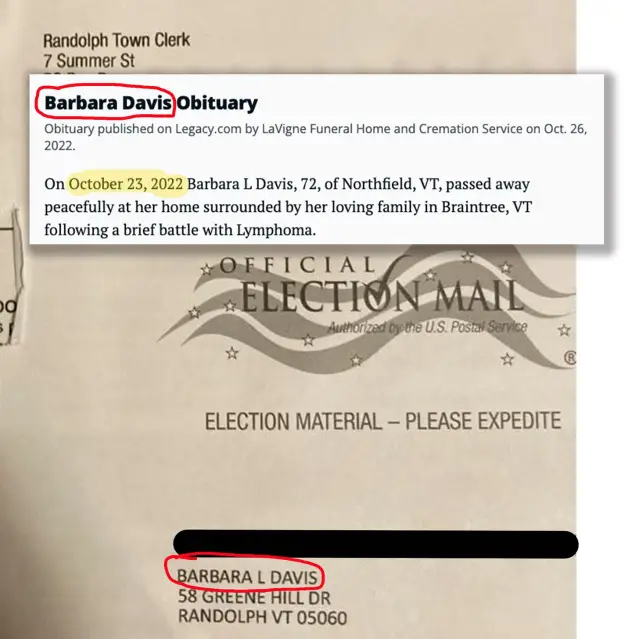Deputy Secretary of State Lauren Hibbert testified before the House Appropriations Committee regarding a number of the office’s budget issues, including elections. Hibbert noted that historically, about 60 percent of Vermont’s $5 million yearly budget to run elections ($10 million for two-year election cycles) comes from federal grants, including those from the federal Help Americans Vote Act (HAVA). Those numbers are facing cuts.
“We cannot and do not anticipate getting federal funding at even close to the same level,” Hibbert explained that after an initial $8 million grant, the state has been receiving $1 million per year ($2 million per election cycle) from HAVA. Not anymore! But the office has saved $6 million in interest payments on those grants and still has that amount on hand.
Universal Vote by Mail in Vermont started as a Covid emergency measure in 2020 and was made permanent policy for the 2022 election and beyond, and, as such, is now required by law. The question is, can we afford to continue with it. And if not, what planning does the legislature need to undertake regarding what to do next?
Hibbert testified that mailing ballots to all voters in the state, regardless of request, costs approximately $1.5 million, with about half of that cost attributed to the printing of ballots, which is a necessary expense.
As with much of agency testimony these days, Hibbert’s main objective seemed to be to get the lawmakers to replace any lost federal dollars with Vermont taxpayer-provided funds. She repeatedly emphasized the popularity of vote-by-mail, noting that the program has increased voter participation.
The first point is undoubtedly true. The second is debatable. The problem with Vermont’s vote-by-mail system is that it contains absolutely zero ballot security measures. We now mail “live” ballots out to everyone on the voter checklist. In many cases, these ballots are sent to individuals who have passed away, moved away, or have chosen not to vote. Every such instance creates the potential for someone to find, steal, or purchase an errant ballot, fill it out, sign the name of the intended recipient, and cast it in an unmonitored drop box. And, if this type of fraud occurs, there is virtually no way for election officials to detect (let alone trace and prosecute) that it is happening.

The level of fraud could be insignificant; it could be massive. We really don’t know. But, given the number of state house and senate elections that are decided by a handful of votes, this is potentially a very dangerous situation for, I’ll steal the term because in this case it actually applies, “our democracy.” (Or, more accurately, our Constitutional Republic.)
Advocates are fond of saying “there is no evidence of voter fraud,” which is true – because the Vermont’s system allows no mechanisms for either preventing or detecting vote-by-mail fraud. But absence of evidence is not evidence of absence. Before the invention of the microscope, there was no evidence that bacteria existed, not because bacteria didn’t exist, but because there was no way to detect them. That, of course, didn’t stop it from wiping out two-thirds of the European population on a couple of occasions. And as far as our elections are concerned, Montpelier has smashed every microscope in the lab and refuses to allow any new ones to be employed.
All of which begs the question: Is the increase in voter participation legitimate, or the result of some folks casting multiple ballots under multiple names? We don’t and can’t know. Therein lies the problem.
However, the program is popular with honest voters because it’s convenient, and, being honest, they don’t see the danger it poses regarding cheaters. It’s popular with cheaters because, well, it makes it really easy to cheat and nearly if not entirely impossible to get caught. Democrats love it because they love anything that obliterates standards and obligations (and I suspect they cheat). A significant number of Vermont Republicans love it because they see vote-by-mail as a contributing factor to their historic election pickups in 2024. Therefore, a legislative move toward a safe, secure, and verifiable election system is unlikely.
But maybe Vermonters could find ourselves reluctantly doing the right thing if a lack of federal funds forces good policy to replace this farcical ballot sieve we have now. As Rep. Jim Harrison (R-Chittenden) noted, “I understand the participation, the convenience, all of that, but I’m also looking at the fiscal realities.”
Reality, yes. But since when has reality been a guiding light for the folks in Montpelier? Rather than facing fiscal facts, lawmakers and election officials want to EXPAND the program we aren’t going to be able to afford. Hibbert testified that there is a movement underway to include future school board elections and school budget votes following education governance reform in mandatory vote-by-mail. In the immortal words of Charlie Brown, “Good grief!”